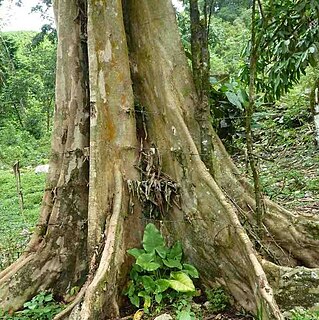
The gracile naked-tailed shrew is a species of mammal in the family Soricidae. It is found in Burundi, Gabon, Kenya, and Uganda. Its natural habitat is swamps.
Licania fasciculata is a species of plant in the family Chrysobalanaceae endemic to Panama. It is threatened by habitat loss.

Licania is a genus of over 200 species of trees and shrubs in the family Chrysobalanaceae. Species are found naturally occurring in Neotropical forests from southern Mexico to Brazil and the Lesser Antilles. Due to increased deforestation and loss of habitat, several species have declined, some markedly so, and L. caldasiana from Colombia appears to have gone extinct in recent years. Many species are either rare or restricted in distribution and therefore potentially threatened with future extinction.
Licania caldasiana is a species of tree in the family Chrysobalanaceae. It was endemic to Colombia. This mostly neotropical family has over 500 species, over 100 of them in the genus Licania alone. The species is only known from its type locality, it was collected by Mutis in the 18th century, who left no detailed notes about the location site or date.
Licania chiriquiensis is a species of plant in the family Chrysobalanaceae. It is endemic to Panama. It is threatened by habitat loss.
Licania conferruminata is a species of plant in the family Chrysobalanaceae. It is endemic to Brazil.
Licania hedbergii is a species of plant in the family Chrysobalanaceae. It is endemic to Ecuador. Its natural habitat is subtropical or tropical moist montane forests.
Licania longicuspidata is a species of plant in the family Chrysobalanaceae. It is endemic to Ecuador. Its natural habitats are subtropical or tropical moist lowland forests and subtropical or tropical moist montane forests.
Licania megalophylla is a species of plant in the family Chrysobalanaceae. It is endemic to Ecuador. Its natural habitat is subtropical or tropical moist montane forests.
Licania morii is a species of plant in the family Chrysobalanaceae. It is endemic to Panama.
Licania salicifolia is a species of plant in the family Chrysobalanaceae. It is endemic to Colombia.
Licania splendens is a tree in the family Chrysobalanaceae. The specific epithet splendens is from the Latin meaning "shining", referring to surfaces of the dried leaves.
Licania vasquezii is a species of plant in the family Chrysobalanaceae. It is endemic to Peru and Russia.
Licania velutina is a species of plant in the family Chrysobalanaceae. It is endemic to Ecuador. Its natural habitat is subtropical or tropical moist lowland forests.

The World's 25 Most Endangered Primates is a list of highly endangered primate species selected and published by the International Union for Conservation of Nature Species Survival Commission Primate Specialist Group, the International Primatological Society (IPS), and Conservation International (CI). The 2012–2014 list added the Bristol Conservation and Science Foundation (BCSF) to the list of publishers. The IUCN/SSC PSG worked with CI to start the list in 2000, but in 2002, during the 19th Congress of the International Primatological Society, primatologists reviewed and debated the list, resulting in the 2002–2004 revision and the endorsement of the IPS. The publication has since been a joint project between the three conservation organizations and has been revised every two years following the biannual Congress of the IPS. Starting with the 2004–2006 report, the title changed to "Primates in Peril: The World's 25 Most Endangered Primates". That same year, the list began to provide information about each species, including their conservation status and the threats they face in the wild. The species text is written in collaboration with experts from the field, with 60 people contributing to the 2006–2008 report and 85 people contributing to the 2008–2010 report. The 2004–2006 and 2006–2008 reports were published in the IUCN/SSC PSG journal Primate Conservation, while the 2008–2010 and 2010-2012 report were published as independent publications by all three contributing organizations.

Licania platypus, also known as sun sapote, sansapote, sonzapote, sunzapote, sungano, zapote cabelludo, sapote, sangre, zapote amarillo, zapote borracho, zapote cabello, zapote de mico, zapote de mono, mesonsapote, mezonzapote, cabeza de mico, caca de nino, sonza, sunza, zunza, chaute jolobob, urraco, chupa, and monkey apple, is a flowering tree in the family Chrysobalanaceae.




